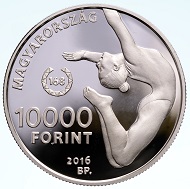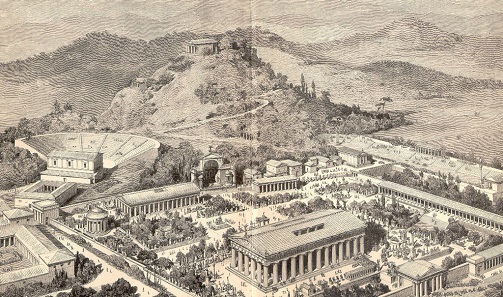August 18, 2016 – In the history of the modern Summer Olympics, the 2016 event in Rio de Janeiro will be the 31st Games. A total of 22 Winter Games have been organised since 1924 and the Paralympic Games have been held 14 times since 1960. Between 1924 and 1992, the Summer and Winter Games were held in the same year, but since then they are staggered by two years.
The Magyar Nemzeti Bank joined the international programme of Olympic coins in 1980 and has issued collector coins for every Summer Olympics since 1984. In keeping with this tradition, it is issuing coins to honour the XXXI. Summer Olympic Games in Rio, designed by graphic artist Andrea Horváth, in three denominations, made of three materials.
Hungary / 10,000 Forint / Silver .925 / 37mm / 24g / Design: Andreas Horváth / Mintage: 5,000.
Each of the versions features the logo of the Hungarian Olympic Team and the emblem of the Hungarian Olympic Committee incorporating the number 168, in reference to the gold medals won by Hungarian Olympians. A female gymnast is depicted on the coins, and the silver and non-ferrous versions also show six key sports: gymnastics, fencing, swimming, kayaking and canoeing, wrestling and water polo.
View of ancient Olympia, illustration in Pierers Universal-Lexikon, 1891.
The Olympic Games are the world’s largest, most watched sporting event. The roots of the Games reach back to ancient times. The first Olympics were held in Olympia, Greece in 776 BC and occurred all the way until 394 AD. The Games were revived under the leadership of Pierre de Coubertin, and the first Olympics in modern times were held in 1896 in Athens. The French baron also played a key role in the creation of the International Olympic Committee on 23 June 1894 in Paris.
The first president of the organisation was Demetrios Vikelas from Greece, and the executive board also included a Hungarian member, Ferenc Kemény. One year after the establishment of the IOC in Paris, the Hungarian Olympic Committee (MOB) was formed on 19 December 1895, headed by Dr Albert Berzeviczy. It was thus the 6th National Olympic Committee. During the 120-year history of the MOB, Hungarian athletes have won a total of 168 gold medals. The Committee’s current president is Zsolt Borkai.
2016 Olympic Games
At the 121st Congress of the International Olympic Committee held in Copenhagen in October 2009 it was decided that Rio de Janeiro would host the XXXI Summer Olympic Games and the subsequent Paralympics. The Brazilian metropolis had previously submitted three unsuccessful bids and was chosen in the final vote over the cities Chicago, Tokyo and Madrid. This will be the first time that South America hosts the Olympic Games. The Olympics will be held August 5-21 and the Paralympic Games September 7-18.
Statue of a discus thrower in the National Roman Museum Palazzo Massimo alle Terme. Photograph: Livioandronico2013 / https://creativecommons.org/licenses/by-sa/4.0/deed.en
A total of 10,500 athletes from more than 200 nations are expected to participate in the Rio Olympics in the 306 events (161 male, 136 female and 9 mixed events), accompanied by some 5,000 attendants, including trainers, sports managers and medical personnel. Tens of thousands of media and press representatives will also be covering the Games. The Hungarian Olympic Team being sent to Rio will compete in 20 sports and likely consist of 135-140 athletes.
More information on these and other issues is available here.
Interesting facts about the ancient Olympics are assembled here and here.
Wikipedia provides a good overview of the modern Olympic Games and the Paralympics.
And it’s easy to keep up with the Rio 2016 Olympics through its official website.








